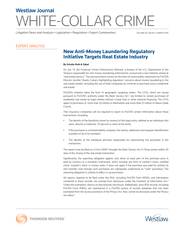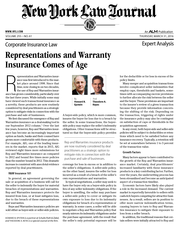Description
Thursday, March 31, 2016
Warranties policies continue to make these
products an effective option. For example,
sellers, particularly investment funds, may
prefer to limit both their indemnity exposure
and the amount of sale proceeds that would
otherwise be tied up in escrow accounts to
cover holdback obligations. These investment
funds may prefer to close out transactions,
pay off related debt and make distributions to
their investors. By acquiring a Rep and Warranties policy, the sellers can reduce or eliminate
the need to hold back funds to cover their
potential indemnity obligations.
In some cases, management of an acquired
entity will continue to run the acquired business after closing.
The same managers who were owners prior to the sale may continue to have some equity stake after the transaction. In other situations, the sellers may be a customer or supplier of the acquired business. In all of these circumstances, it may be awkward for the buyer to bring indemnification claims against the sellers. A Rep and Warranties policy can shift the majority of exposure for breaches to the insurer and allow buyers to recover without damaging possibly important business relationships. Finally, market capacity has also increased over the last few years with more insurers entering and competing in the market place. Premiums for typical policies continue to range from 2 to 5 percent of the transaction value, but higher limits are now available with many insurers also willing to offer excess insurance to fill out a tower.
In addition, while the United States and Canada remain the more active markets, Rep and Warranties insurance is now available in some foreign markets as well. Underwriting Process The underwriting process typically begins with the execution of a non-disclosure agreement and submission to the insurers of certain key documents, including a draft of the acquisition agreement and the relevant financial information. Within a short period of time, the insurer will issue a quote subject to due diligence requirements. In order to proceed, the insured than must pay an underwriting fee to the insurer.
Following receipt of the fee, the insurer will commence more comprehensive due diligence which will include access to additional documents and information as well as communications with the deal team. Negotiations on policy terms will then follow before binding of coverage. There are a number of important underwriting considerations, starting with the identity of the buyer, seller and their advisors and the type and location of the business that is the subject of the transaction. The underwriters will evaluate the transaction based primarily on the deal documents, other due diligence materials and their experience with the type of risk. Familiarity with the parties—the buyers, sellers and/or their advisors—through repeat business may also help the insurers get comfortable with a risk more quickly. Depending on the transaction, the scope of exclusions to coverage may need to be negotiated.
There may be specific representations or warranties that an insurer is not willing to cover. While this will vary to a degree from transaction to transaction, insurers will typically exclude certain environmental and There may be specific representations or warranties that an insurer is not willing to cover. While this will vary to a degree from transaction to transaction, insurers will typically exclude certain environmental and product liability risks as well as other risks that should be covered by other existing insurance. product liability risks as well as other risks that should be covered by other existing insurance.
In addition, Rep and Warranties policies will exclude coverage for breaches that were known to deal team members prior to inception of the policy or prior to execution of a no claims declaration. Claims Experience Recently, AIG published a report providing information concerning claims experience under its Rep and Warranties policies.2 The report tracks the frequency and subject matter of claims reported from 2011–2014 in the United States and globally. According to AIG, a claim was reported under approximately one in every seven policies issued globally. Transactions that were larger than $1 billion resulted in a claim 19 percent of the time, but smaller deals still resulted in claims at a rate of 13 percent to 15 percent. Claims were more likely to be reported under seller-side policies, but claims under buyer-side policies resulted in larger average losses. Globally, the most commonly alleged claims involved breaches related to representations in financial statements.
Other commonly alleged breaches concerned tax information and contracts. In the United States, a more varied range of breaches also included intellectual property, data and insurance-related representations. As far as timing, more than half of all global claims were reported within a year after closing, and almost three-quarters were reported within 18 months. Nevertheless, approximately a quarter of all claims were reported more than 18 months after closing of the transaction. Looking Forward Each Rep and Warranties policy will vary to some degree based on the specific risks associated with the transaction.
Negotiating your policy will likely require teamwork between your deal practitioners and insurance experts. However, if you start with a proven policy form, you are more likely to end up with a suitable final product. The growing market and growing demand for Rep and Warranties insurance demonstrates that this product has become a valuable tool for deal makers which allows parties to a transaction to mitigate the risks associated with breaches of representations and warranties. The experience of the last few years suggests that use of these policies will continue to grow as more practitioners gain experience with the product. •••••••••••••••• ••••••••••••• 1. Howard B.
Epstein and Theodore A. Keyes, “Representations and Warranties Insurance as Deal Making Tool”, N.Y.L.J. Vol.
248, No. 59, September 24, 2012. 2. What Happens After a Deal Closes?: Representations and Warranties Insurance Global Claims Study (AIG 2016). Reprinted with permission from the March 31, 2016 edition of the NEW YORK LA JOURNAL © 2016 ALM Media Properties, LLC.
All rights reserved. Further W duplication without permission is prohibited. For information, contact 877-257-3382 or reprints@alm.com.
# 070-03-16-42 .
The same managers who were owners prior to the sale may continue to have some equity stake after the transaction. In other situations, the sellers may be a customer or supplier of the acquired business. In all of these circumstances, it may be awkward for the buyer to bring indemnification claims against the sellers. A Rep and Warranties policy can shift the majority of exposure for breaches to the insurer and allow buyers to recover without damaging possibly important business relationships. Finally, market capacity has also increased over the last few years with more insurers entering and competing in the market place. Premiums for typical policies continue to range from 2 to 5 percent of the transaction value, but higher limits are now available with many insurers also willing to offer excess insurance to fill out a tower.
In addition, while the United States and Canada remain the more active markets, Rep and Warranties insurance is now available in some foreign markets as well. Underwriting Process The underwriting process typically begins with the execution of a non-disclosure agreement and submission to the insurers of certain key documents, including a draft of the acquisition agreement and the relevant financial information. Within a short period of time, the insurer will issue a quote subject to due diligence requirements. In order to proceed, the insured than must pay an underwriting fee to the insurer.
Following receipt of the fee, the insurer will commence more comprehensive due diligence which will include access to additional documents and information as well as communications with the deal team. Negotiations on policy terms will then follow before binding of coverage. There are a number of important underwriting considerations, starting with the identity of the buyer, seller and their advisors and the type and location of the business that is the subject of the transaction. The underwriters will evaluate the transaction based primarily on the deal documents, other due diligence materials and their experience with the type of risk. Familiarity with the parties—the buyers, sellers and/or their advisors—through repeat business may also help the insurers get comfortable with a risk more quickly. Depending on the transaction, the scope of exclusions to coverage may need to be negotiated.
There may be specific representations or warranties that an insurer is not willing to cover. While this will vary to a degree from transaction to transaction, insurers will typically exclude certain environmental and There may be specific representations or warranties that an insurer is not willing to cover. While this will vary to a degree from transaction to transaction, insurers will typically exclude certain environmental and product liability risks as well as other risks that should be covered by other existing insurance. product liability risks as well as other risks that should be covered by other existing insurance.
In addition, Rep and Warranties policies will exclude coverage for breaches that were known to deal team members prior to inception of the policy or prior to execution of a no claims declaration. Claims Experience Recently, AIG published a report providing information concerning claims experience under its Rep and Warranties policies.2 The report tracks the frequency and subject matter of claims reported from 2011–2014 in the United States and globally. According to AIG, a claim was reported under approximately one in every seven policies issued globally. Transactions that were larger than $1 billion resulted in a claim 19 percent of the time, but smaller deals still resulted in claims at a rate of 13 percent to 15 percent. Claims were more likely to be reported under seller-side policies, but claims under buyer-side policies resulted in larger average losses. Globally, the most commonly alleged claims involved breaches related to representations in financial statements.
Other commonly alleged breaches concerned tax information and contracts. In the United States, a more varied range of breaches also included intellectual property, data and insurance-related representations. As far as timing, more than half of all global claims were reported within a year after closing, and almost three-quarters were reported within 18 months. Nevertheless, approximately a quarter of all claims were reported more than 18 months after closing of the transaction. Looking Forward Each Rep and Warranties policy will vary to some degree based on the specific risks associated with the transaction.
Negotiating your policy will likely require teamwork between your deal practitioners and insurance experts. However, if you start with a proven policy form, you are more likely to end up with a suitable final product. The growing market and growing demand for Rep and Warranties insurance demonstrates that this product has become a valuable tool for deal makers which allows parties to a transaction to mitigate the risks associated with breaches of representations and warranties. The experience of the last few years suggests that use of these policies will continue to grow as more practitioners gain experience with the product. •••••••••••••••• ••••••••••••• 1. Howard B.
Epstein and Theodore A. Keyes, “Representations and Warranties Insurance as Deal Making Tool”, N.Y.L.J. Vol.
248, No. 59, September 24, 2012. 2. What Happens After a Deal Closes?: Representations and Warranties Insurance Global Claims Study (AIG 2016). Reprinted with permission from the March 31, 2016 edition of the NEW YORK LA JOURNAL © 2016 ALM Media Properties, LLC.
All rights reserved. Further W duplication without permission is prohibited. For information, contact 877-257-3382 or reprints@alm.com.
# 070-03-16-42 .
Personal Finance Presentations
+
Personal Finance Sub Categories
Schulte Roth & Zabel









